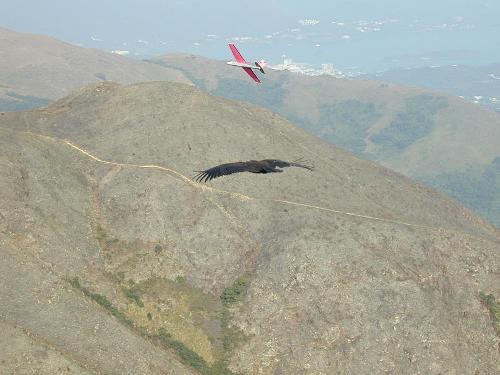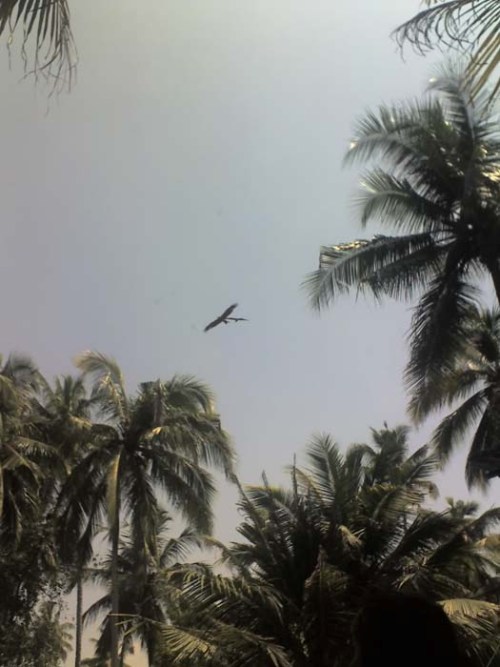
May 13, 2007
Please click on image for full size version
The above photograph was sent to me via a Cryptomundo reader.
Maybe people are already aware of this photo of a giant bird sighting. And maybe it’s a hoax. It looks pretty real to me though. I was stunned when I first saw it. Wish I knew who took it.
It is from a Hong Kong website, where people who fly RC airplanes post pictures. One of the pictures has an RC flying in front of an enormous eagle-looking bird. Kate, sent to Cryptomundo, May 2007

French cryptozoologist Michel Raynal forwards the next photograph (above) from an Indian source. Raynal writes: “The picture is very impressive, indeed, but it might be an optical illusion.”
Raynal received the following information on the photograph:
I think I saw 2 gigantic birds above my house in Kerala, India. I guess the wingspan must be that of a small plane. I took a pic with my Motorazor v3i. Thunderbird in Kerala, India?
Raynal followed up with various questions, and filled out the background on the picture with this:
I’m a 32 yr Government Officer settled in the city of Trivandrum, Kerala State, India.
The pic was taken in March 2007. I don’t recall the exact date.
The birds suddenly appeared overhead (this was noon) when I was on my terrace. They seemed too large to be an eagle or other bird and albatross, Andean condor, etc. do not exist in India. I suppose the wing span must have been the size of a Cessna aircraft. I was too surprised to take a second pic, they passed overhead and left. I guess this is the first report of a “thunderbird” from the East.
Kerala has numerous coconut trees which are very large, hundreds of feet high. You can make out in the pic that the first bird, even though being much higher than the coconut trees, still appears to be very large. If it had been on the ground, the size would have been gigantic.
I am unwilling to provide my exact address and name, as I desire my privacy and I don’t want to be bugged by unwanted people.Samedi, May 12, 2007
These photographs are not to be confused with recent news of a sick, underweight cinereous vulture, supposedly from Mongolia, which was actually captured in Thailand several months ago. By the time it was released on May 10, 2007, it had grown to weigh about 18 pounds, and its wing span had grown past 9 feet in captivity. Or are they?
* * *
The cinereous vulture – nicknamed Anakin after the Star Wars character who becomes Darth Vader – was found in southeastern Thailand in December [2006], emaciated and apparently lost. Also known as the black or monk vulture, the species is in decline in Asia because of habitat loss, shortage of food and poisoning.
* * *
The cinereous vulture – normally not found in Thailand – is defined as near-threatened by the World Conservation Union. Though its numbers are declining in Asia, conservation efforts have boosted the population in Greece, Spain and other parts of Europe. Its global population is estimated at between 14,400 and 20,000.
* * *
“Rare vulture freed in Thailand
May 11, 2007
Could these photographs be photographs of vultures flying farther south than previously or regularly known?
The Eurasian Black Vulture (Aegypius monachus) is also known as the Monk Vulture, the Cinereous Vulture, or just the Black Vulture. It is a member of the family Accipitridae which also includes many other diurnal raptors such as kites, buzzards and harriers. This bird is an Old World vulture, and is not related to the New World vultures which are in a separate family Cathartidae. It is therefore also unrelated to the American Black Vulture despite the similar name and coloration. It breeds across southern Europe and Asia from Spain to Japan, but is endangered throughout its European range. It is resident except in those parts of its range where hard winters cause limited movement. It is the largest bird of prey (Falconiformes) in the world (as the unrelated, slightly larger Andean Condor is now affiliated with the Ciconiiformes). This huge bird is 110-120 cm (43-48 inches) long with a 250-300 cm (8-10 foot) wingspan and a body mass of up to 14 kg (31 lbs.) thus making it one of the world’s heaviest flying birds. It breeds in high mountains and large forests, nesting in trees. It has all dark plumage, and even at a distance can be distinguished from Griffon Vulture by its evenly broad “barn door” wings. It has the typical vulture “bald” head, and dark markings around the eye give it a menacing skull like appearance. The Eurasian Black Vulture is usually larger than Griffon Vulture. Among the vultures in its range, the Eurasian Black Vulture is best equipped to tear open tough carcass skins, ably using its powerful bill. It dominates all other vultures at carcasses.“Eurasian Black Vulture,” Wikipedia
So what do you think these new photograph show?
About Loren Coleman
Loren Coleman is one of the world’s leading cryptozoologists, some say “the” leading living cryptozoologist. Certainly, he is acknowledged as the current living American researcher and writer who has most popularized cryptozoology in the late 20th and early 21st centuries.
Starting his fieldwork and investigations in 1960, after traveling and trekking extensively in pursuit of cryptozoological mysteries, Coleman began writing to share his experiences in 1969. An honorary member of Ivan T. Sanderson’s Society for the Investigation of the Unexplained in the 1970s, Coleman has been bestowed with similar honorary memberships of the North Idaho College Cryptozoology Club in 1983, and in subsequent years, that of the British Columbia Scientific Cryptozoology Club, CryptoSafari International, and other international organizations. He was also a Life Member and Benefactor of the International Society of Cryptozoology (now-defunct).
Loren Coleman’s daily blog, as a member of the Cryptomundo Team, served as an ongoing avenue of communication for the ever-growing body of cryptozoo news from 2005 through 2013. He returned as an infrequent contributor beginning Halloween week of 2015.
Coleman is the founder in 2003, and current director of the International Cryptozoology Museum in Portland, Maine.
Filed under Breaking News, Cryptomundo Exclusive, Cryptotourism, CryptoZoo News, Cryptozoologists, Cryptozoology, Evidence, Photos, Thunderbirds